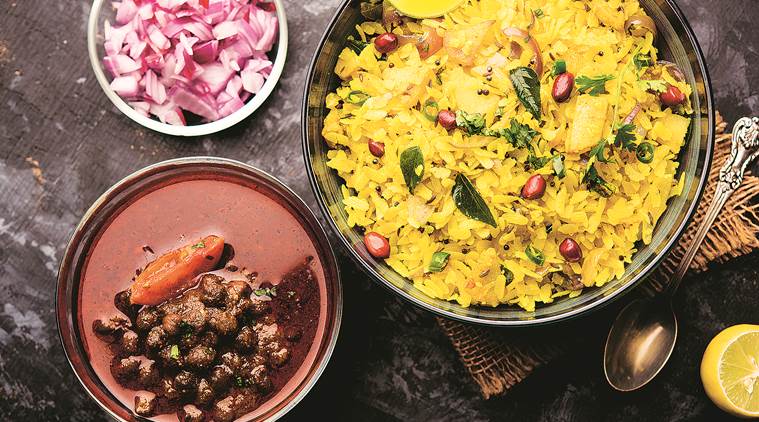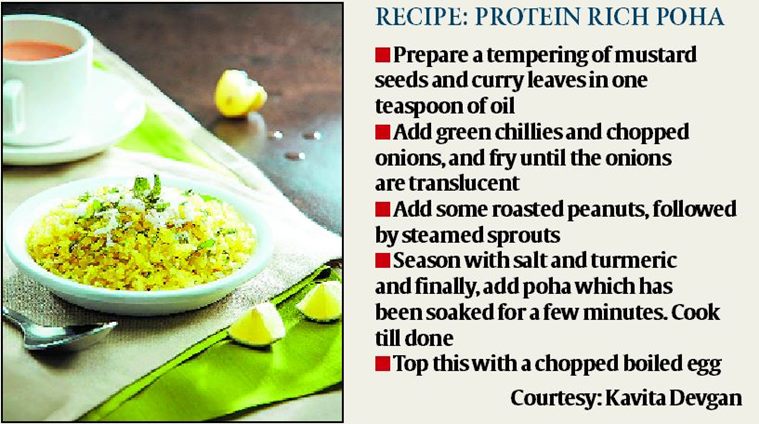
What makes the perfect breakfast? According to those who swarm every morning to Aaswad Uphar and Mithai Gruh in Dadar, Mumbai, it’s a plate of steaming hot poha (flattened rice). Whether it’s kanda pohe (onion poha), batata pohe (potato poha) or the spicier vangi pohe (brinjal pohe, flavoured with traditional Maharashtrian goda masala), this breakfast staple is the hottest selling category at the eatery that is otherwise known for its fiery misal pav. “We have a kiosk at the airport and even there, if there’s poha on the menu, people opt for that over any other breakfast dish like sandwiches. It’s made fresh, nutritious and easy to digest — what more do people want,” says its owner Suryakant Sarjoshi.
On most days, he says, they end up making pohe twice a day — once in the morning and once in the afternoon, because the demand is so high. On the weekend, when non-regulars finally find the time to make their way to south Mumbai, the kitchen at Aaswad prepares poha twice in the morning itself. “It’s a classic,” says Sarjoshi.
This breakfast dish has recently been in the news, thanks to an application made by the Indori Mithai Aur Namkeen Nirmata-Vikreta Vyapari Sangh to grant a Geographical Indication (GI) tag to the Indori Poha. “We’ve sought the tag for four dishes — apart from Indori Pohe, there’s laung sev, khatta-meetha mixture and dahi ki shikanji which is unique to Indore,” says Anurag Bothra, secretary of the association, adding, “The Indori Pohe, unlike the Maharashtrian version, is a full meal in itself. Most commonly, it is served with sev on top, but there’s also usal pohe, with a spicy gravy poured over it. This is heavier than the regular pohe you get in Maharashtra.” The association, Bothra says, is not staking a claim on Indore being the birthplace of poha. “Rather, the Indori Poha has a separate character and taste, and this is what we want recognised,” he adds.
Shorn of all the bells and whistles that have made the Indori Poha so distinct, the poha, in its most basic form, is a healthy dish that, according to nutritionist Kavita Devgan, is unfortunately misunderstood. “Most people consider poha just a high carb snack. They don’t understand its health benefits. In fact, very often, people go off it when on a weight-loss diet, considering it to be a high-calorie dish, which is wrong. They need to be educated about how to make it right — with lots of vegetables to increase the fibre content and boost its value and cut its calories down,” says Devgan.

Poha is useful for delivering iron into the body because it has a slightly higher iron content than the rice from which it is made. This, says Devgan, is because of the pounding process itself, used to create flattened rice from rice. “But for the iron to be properly absorbed by the body, there needs to be some vitamin C, which is why we usually squeeze lime over poha before eating it,” she says. It is also easier to digest than rice, she says, even if a single flake of poha looks heavier in volume than a single grain of rice.
At Aaswad — and across Maharashtra and other parts of the country — poha is one of the quickest dishes to prepare. This, perhaps, is what accounts for its popularity, as does the fact that the basic ingredients to make a simple kanda pohe — onions, poha, green chillies, curry leaves, peanuts and lime — are affordable.
If the GI tag is granted, it will certainly raise the profile of what is otherwise a humble dish, accessible to all, says Devgan. “It will help the businesses who make this poha get global recognition for sure, but I don’t know about the benefits for the common man in this process. In fact, I’m worried this might push the price of this highly affordable snack up,” she says.
What is a GI tag?
A geographical indication (GI) is used to denote the name or sign of products specific to certain geographical locations. The tag is granted by the government, in keeping with the definition provided under Article 22 (1) of the WTO Agreement on Trade-Related Aspects of Intellectual Property Rights. This definition states: “Indications which identify a good as originating in the territory of a member, or a region or a locality in that territory, where a given quality, reputation or characteristic of the good is essentially attributable to its geographic origin.” India, as a member of the WTO, enacted the Geographical Indication of Goods (Registration and Protection) Act, 1999, and, since the Act came into force in 2003, has registered 323 goods. Among the food products registered under the act are Dharwad Peda (Karnataka), Tirupathi Laddu (Andhra Pradesh), Bikaneri Bhujia (Rajasthan) and Hyderabad Haleem (Telangana).